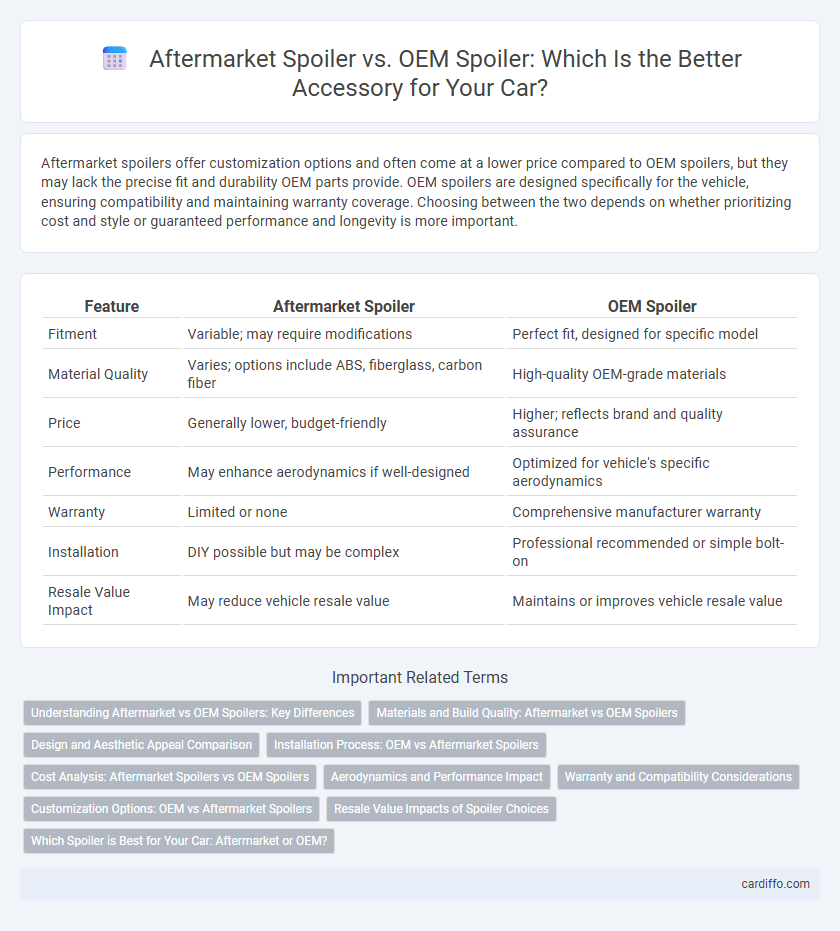Aftermarket spoilers offer customization options and often come at a lower price compared to OEM spoilers, but they may lack the precise fit and durability OEM parts provide. OEM spoilers are designed specifically for the vehicle, ensuring compatibility and maintaining warranty coverage. Choosing between the two depends on whether prioritizing cost and style or guaranteed performance and longevity is more important.
Table of Comparison
| Feature | Aftermarket Spoiler | OEM Spoiler |
|---|---|---|
| Fitment | Variable; may require modifications | Perfect fit, designed for specific model |
| Material Quality | Varies; options include ABS, fiberglass, carbon fiber | High-quality OEM-grade materials |
| Price | Generally lower, budget-friendly | Higher; reflects brand and quality assurance |
| Performance | May enhance aerodynamics if well-designed | Optimized for vehicle's specific aerodynamics |
| Warranty | Limited or none | Comprehensive manufacturer warranty |
| Installation | DIY possible but may be complex | Professional recommended or simple bolt-on |
| Resale Value Impact | May reduce vehicle resale value | Maintains or improves vehicle resale value |
Understanding Aftermarket vs OEM Spoilers: Key Differences
Aftermarket spoilers offer a wide range of customizable options, often at a lower cost, but may vary in quality and fit compared to OEM spoilers, which are specifically designed and tested to match the original vehicle specifications. OEM spoilers provide guaranteed compatibility and durability, ensuring optimal aerodynamics and maintaining factory warranty compliance. Understanding these differences helps consumers balance cost, aesthetics, and performance when choosing between aftermarket and OEM spoilers.
Materials and Build Quality: Aftermarket vs OEM Spoilers
Aftermarket spoilers often use a variety of materials such as fiberglass, ABS plastic, or carbon fiber, offering diverse options but sometimes compromising on durability and fitment precision. OEM spoilers are typically constructed with high-quality, vehicle-specific materials that ensure optimal build quality, perfect fit, and long-term reliability. The superior manufacturing standards of OEM spoilers generally provide better aerodynamic performance and a seamless integration with the vehicle's design.
Design and Aesthetic Appeal Comparison
Aftermarket spoilers often provide more aggressive and customizable design options, allowing car enthusiasts to tailor the aesthetic appeal to their personal style. OEM spoilers typically prioritize seamless integration with the vehicle's original body lines, maintaining a factory-finished look with subtle enhancements. The choice between aftermarket and OEM spoilers depends on whether the priority is unique visual impact or cohesive design harmony with the car's existing aesthetics.
Installation Process: OEM vs Aftermarket Spoilers
OEM spoilers typically offer a seamless installation process as they are designed specifically for the vehicle model, ensuring perfect fitment and compatibility with existing mounting points. Aftermarket spoilers may require modifications such as drilling or custom brackets, increasing installation complexity and time. Choosing OEM spoilers reduces the risk of installation errors, while aftermarket options provide more variety but often demand professional expertise for proper attachment.
Cost Analysis: Aftermarket Spoilers vs OEM Spoilers
Aftermarket spoilers generally cost 30-50% less than OEM spoilers due to lower production and branding expenses, making them a budget-friendly option for car enthusiasts. OEM spoilers offer precise fitment, guaranteed compatibility, and manufacturer-backed quality, often justifying their higher price point with long-term durability. Cost analysis should weigh the initial savings of aftermarket spoilers against potential additional expenses for modifications or repairs that may arise from less precise manufacturing.
Aerodynamics and Performance Impact
Aftermarket spoilers often provide enhanced aerodynamic customization tailored for specific performance needs, improving downforce and reducing drag more aggressively than OEM spoilers. OEM spoilers are designed to balance aesthetic appeal with moderate aerodynamic efficiency, ensuring stability and fuel efficiency without compromising vehicle warranty or safety compliance. The performance impact of aftermarket spoilers varies widely by design and material, frequently offering superior cornering grip and high-speed stability compared to standard OEM options.
Warranty and Compatibility Considerations
Aftermarket spoilers often provide more design options but may void vehicle warranties if not installed according to manufacturer specifications, while OEM spoilers guarantee complete compatibility and maintain original warranty coverage. OEM parts are engineered to fit perfectly with the car's structure and electronics, reducing risks of malfunctions or insurance issues. Choosing OEM ensures seamless integration and adherence to safety standards, whereas aftermarket options require careful assessment of compatibility and warranty impact.
Customization Options: OEM vs Aftermarket Spoilers
Aftermarket spoilers offer a wide range of customization options including various materials, colors, and aggressive designs tailored to individual preferences, allowing car owners to enhance both aesthetics and performance. OEM spoilers provide manufacturer-approved styling and fitment, ensuring seamless integration and maintaining the vehicle's original design integrity with limited customization choices. Choosing between aftermarket and OEM spoilers depends on whether priority lies in personalized customization or in preserving the factory-grade look and quality.
Resale Value Impacts of Spoiler Choices
Choosing an OEM spoiler typically enhances a vehicle's resale value due to its factory fit, finish, and manufacturer warranty, which appeal to buyers seeking authenticity and reliability. Aftermarket spoilers offer customization and potentially improved aerodynamics but may reduce resale value if perceived as lower quality or if installation quality is questionable. Market trends indicate that vehicles retaining OEM accessories generally command higher resale prices in comparison to those modified with aftermarket parts.
Which Spoiler is Best for Your Car: Aftermarket or OEM?
Aftermarket spoilers offer a wider variety of designs and customization options, often at a lower cost, appealing to drivers seeking unique styling and improved aerodynamics. OEM spoilers guarantee perfect fitment, quality assurance, and maintenance of manufacturer warranty, making them ideal for those prioritizing reliability and factory specifications. Choosing between aftermarket and OEM spoilers depends on your preference for customization versus guaranteed compatibility and long-term performance.
Aftermarket spoiler vs OEM spoiler Infographic

 cardiffo.com
cardiffo.com